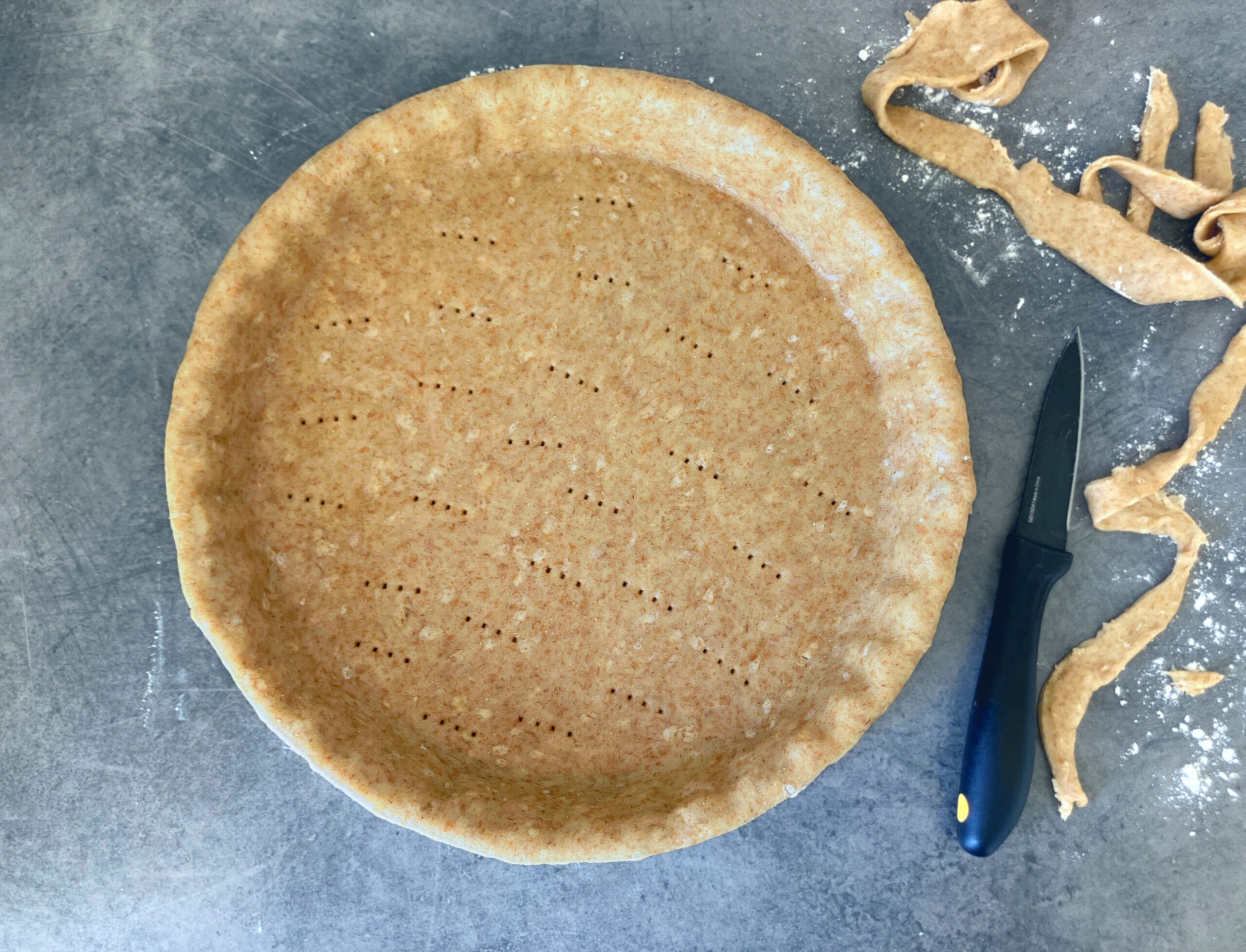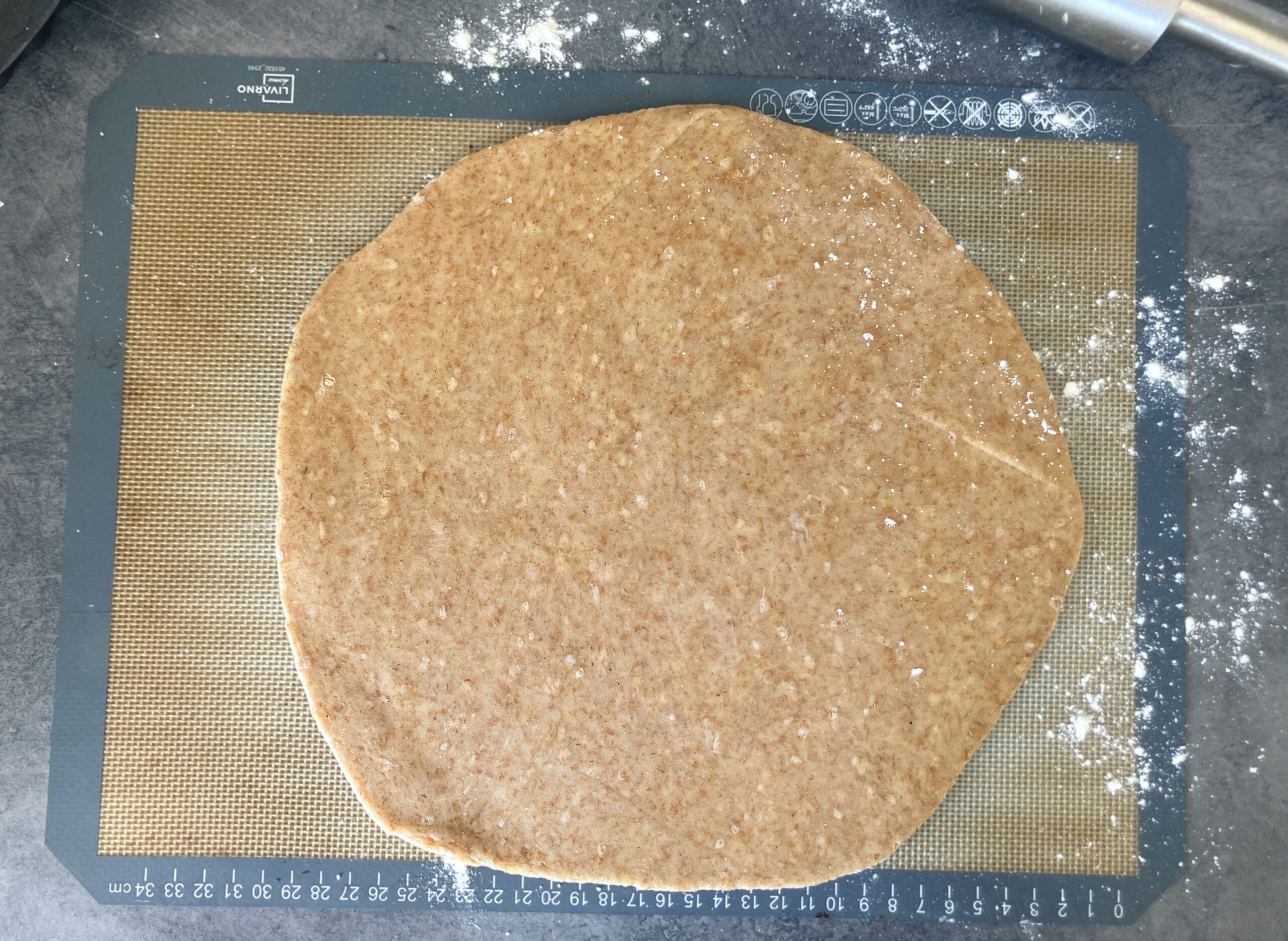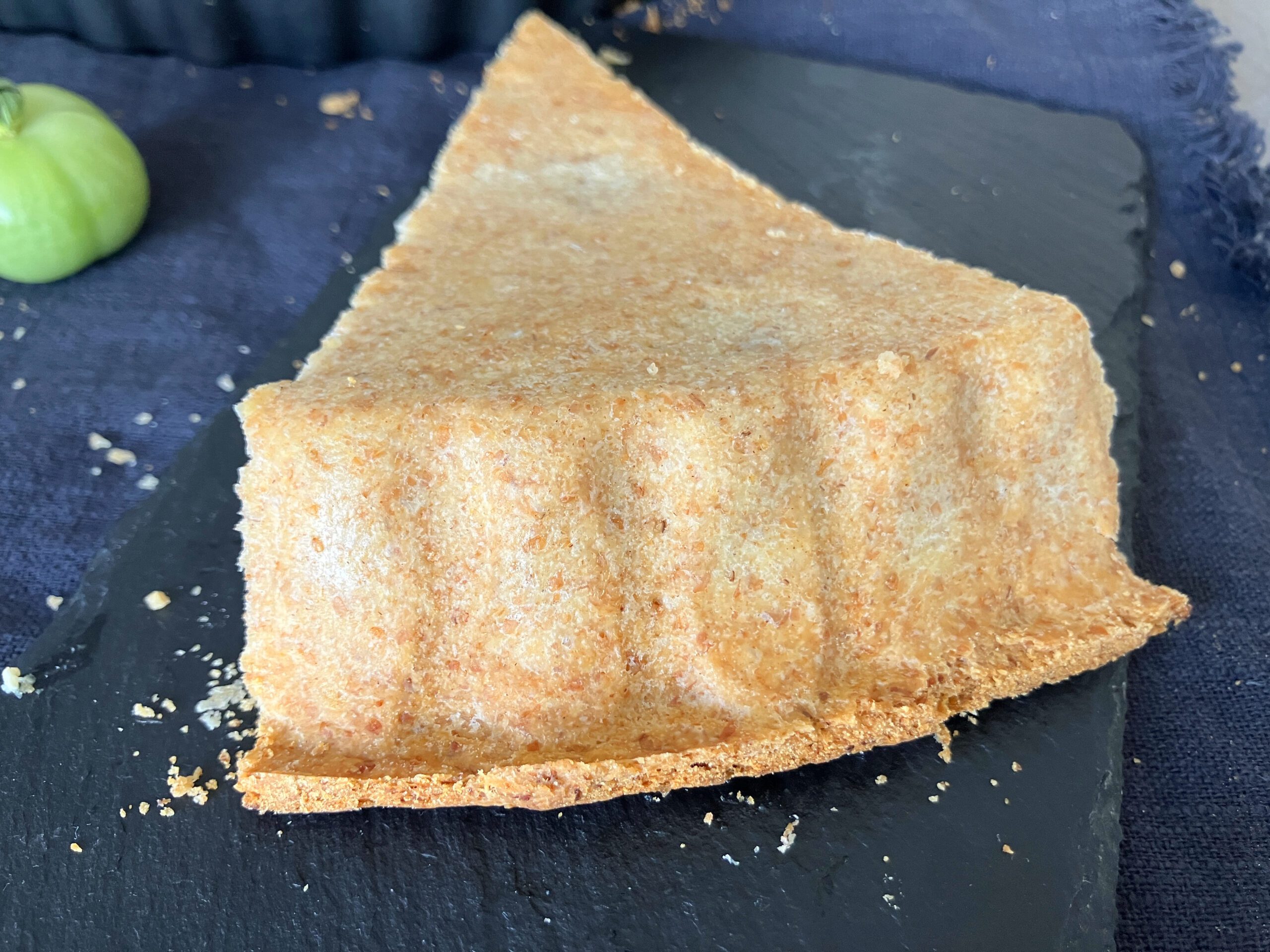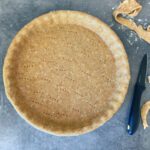Olive Oil & Wholegrain Spelt Pastry Crust
Discover the simplicity and versatility of this olive oil and wholegrain spelt pastry crust. With just 3 ingredients (plus water), it’s tender, flavourful, naturally vegan, and perfect for both sweet and savoury tarts, pies, galettes and quiches.
Skip the long chilling times and blind baking. This super simple, reliable crust is quick to make and easy to handle, making it a recipe you’ll reach for again and again.
If you’re looking for the perfect way to use your pastry crust, check out my lighter cottage cheese quiche.

Olive oil & wholegrain spelt pastry crust
This pastry is simple and full of flavour, made with just three cupboard staples: olive oil, spelt flour, and a pinch of salt. Yes, the water makes four ingredients, if we’re being pedantic. This highlights beautifully that you really don’t need butter, egg or fancy ingredients to produce an amazing, homemade pastry crust.
Using olive oil instead of butter gives it a tender texture and a subtle richness that works with any filling. A mixture of wholegrain and white spelt flour adds body and a wholesome touch, making the pastry more nutritious without losing any taste.
Using olive oil instead of butter in pastry crust
Swapping butter for olive oil might feel unusual if you’re used to classic pastry, but it’s a change that really works. Olive oil gives the pastry dough a tender, soft texture without making it greasy or heavy. It also adds a subtle, pleasant richness that lets the other ingredients shine, while keeping the pastry easy to handle. Unlike butter-based pastry, there’s no need to worry about chilling or overworking the dough. It comes together quickly and easily, making it a perfect choice for a quick tart or quiche.
Olive oil pastry has a long tradition in Mediterranean countries like Italy, Greece, and Spain, where it’s commonly used for both sweet and savoury pies. In Italy, it’s often used for rustic fruit tarts. In Greece, it appears in pies filled with cheese or vegetables. Spain uses it as a staple for empanadas. Using olive oil makes the pastry slightly lighter and a little healthier, without compromising on taste or performance. Even if you’ve always baked with butter, this approach is worth trying. It is surprisingly versatile, and brings a fresh twist to familiar recipes.
Adding water: achieving the perfect dough texture
How much water you add can make the differences between crispy and light or dense pastry.
When adding water to your olive oil and wholegrain spelt pastry dough, start with the minimum, about 4 tablespoons, and mix it in thoroughly. You’re aiming for a dough that is soft but isn’t sticky. Don’t be too quick to add more; this is a patient, slow process. Add a little more water at a time, allowing each addition to fully absorb before deciding if it needs more. The end result should be soft and pliable dough that’s neither sticky nor crumbly.
Once it’s all combined, shape the dough into a ball, wrap it, and let it rest in the fridge for about 20 minutes. This short rest gives the flour a chance to hydrate and the dough to relax, making it even easier to handle. Unlike butter-laded crust, the dough will not firm up substantially. The dough remains soft and pliable rather than firm and flaky. That means it’s easier to work with and less likely to crack when rolling out. And this pastry is a dream to roll out. Seriously. And it moulds to the pie pan like no other pastry I have ever made.
Skip the blind bake
Yes. You read that right.
If you’ve ever baked with butter pastry, you’ve probably heard the advice a thousand times: always blind bake. The process helps to prevent soggy bottoms, especially with juicy fillings. And yes, in most cases, it does help. I’ll admit that. But, foor some reason, I roll my eyes when a recipe calls for baking blind. Sometimes, I ignore it. Such a rebel. Other times, I am a rule follower, but I do it grudgingly. I am not sure why it bothers me so much, but it feels like an unnecessary faff.
Traditional recipes, especially in Mediterranean countries, often trust the dough to bake alongside its filling. Fruit tarts, savory pies, and rustic quiches are typically filled and baked straight away, allowing the crust and filling to cook together. And with this particular recipe, you can sleep easy at night knowing that skipping the blind bake is totally okay.
So go ahead, whip up a wholegrain spelt pastry case and fill your tart or pie and pop it straight in the oven.
Baking the spelt crust
Since this recipe is just for the crust, baking times will vary depending on what you fill it with.
As a rough guide, a 28 cm (11 inch) pie dish filled with a quiche will take around 40–45 minutes at 190 °C (375 °F).
Because the crust is not pre-baked, it needs time to cook through fully. I have tried baking the crust, filled with a quiche mixture, for 35 minutes. The top of the filling was golden and ready, and although the bottom was fully baked, it was just a little softer. The edges were beautifully crisp.
For a crunchier base all the way through, simply leave it in the oven a little longer. To prevent the top from overbaking or browning too much, you can cover it loosely with foil towards the end of the bake.
Every oven is different, so it’s worth keeping an eye on it towards the end. You want the edges golden and firm, and the base cooked through without being soggy. This way, your pie or quiche will have that perfect balance of a tender, slightly crisp crust that holds your filling beautifully.
Taste and texture: olive oil pastry
The proof is in the pudding, as they say. And the proof that baking blind is totally unnecessary in this recipe is very evident. The crust is delightfully crispy and sturdy, providing a satisfying crunch with each bite. Once cooled, it effortlessly pops out of the pan, maintaining its integrity without crumbling.
On my first effort, I even did the “knock test” on the bottom, just to see how solid it was. Yes, I know knocking bottoms is usually reserved for bread, but I wanted to make sure. It passed with flying colours even though it was filled with classic cheese quiche ingredients. Look at the picture below. You can see the crunch coming right through the screen at you. Taking a picture of the bottom of a pie is not something I’ve ever done before, but needs must:
And the all important question: how did it taste? Well, absolutely delicious is the answer. The flavour is clean and lightly savoury, with the olive oil giving a gentle richness along with its unmistakable taste. You’ll notice it enhances the overall taste of the filling rather than competing with it, and it leaves a subtle, lingering depth that’s different from the buttery flavour you’re perhaps used to.
Naturally vegan pastry
One of the things I really love about this crust is that without eggs or butter, it’s naturally vegan. Just to be clear, I’m not vegan myself, but even so, I genuinely enjoy how simple and delicious this crust is. It proves that vegan baking doesn’t have to be complicated or compromise on taste. You can feel clever and virtuous while making it, and everyone, vegans and non-vegans alike, can enjoy the results.
Fillings for an olive oil pastry crust
This olive oil and wholegrain spelt pastry crust is wonderfully versatile, making it a blank canvas for all sorts of fillings. I feel the subtle flavour of the olive oil is better suited for savoury pies, as it complements vegetables, cheeses, and herbs beautifully. In traditional Mediterranean recipes, olive oil-based pastry often holds savoury ingredients such as spinach, tomatoes, roasted vegetables, or cheeses. Simple, fresh flavours that highlight the clean taste of the crust.
The pastry dough would work amazingly well as a galette, too. Effortlessly holding fillings while keeping its crispy, sturdy texture.
Savoury inspiration:
- Roasted vegetables with herbs: perfect for a rustic tart.
- Cheese-based quiches: because cheese makes everything better. Right?
- Spinach and ricotta: classic, rich and comforting.
- Tomato, basil, and mozzarella: like a little Mediterranean holiday in a pie crust.
Although I do feel the pastry is better suited to savoury dishes, and I haven’t tried it as a sweet version, I imagine it could work with fruit compotes, fresh berries, or creamy custards if you’re feeling adventurous. Or just fill the crust with sumptuous chocolate ganache and just be done with it.
Olive Oil & Wholegrain Spelt Pastry Crust
Ingredients
- 125g (1 cup) wholegrain spelt flour (see note 1)
- 125g (1 cup) plain spelt flour (see note 1)
- 1 tsp salt
- 75ml (⅓ cup) olive oil
- 60-100ml (4-7 tbsp) cold water (see note 2)
Instructions
- In a large bowl, whisk together the flours and salt for a light, even base.
- Pour in the olive oil and 60 ml (4 tbsp) of the cold water, then work the ingredients together (I used a stand mixer).
- Gradually add more water, a little at a time, until the dough comes together. You’re aiming for a soft but not sticky healthy pie base. Be patient, letting each addition of water fully absorb before adding more. Your dough should be soft but not sticky.
- Shape the dough into a ball, wrap it in clingfilm, and rest in the fridge for 20–30 minutes. There is no butter, so it won’t firm up like a butter-heavy dough.
- Roll out the dough on a lightly floured surface until it fits your pan (mine was 28 cm) with a slight overhang.
- Press the dough into the pan (no need to grease or line the pan), and trim the edges slightly, leaving some extra to account for shrinking.
Notes
- You can use all-purpose flour instead of spelt flour. I used a combination of wholegrain and white spelt, but feel free to use all white or wholegrain, if you prefer.
- Take care with how much water you add. Start off with four tablespoons and gradually add more. Read here for further information.







